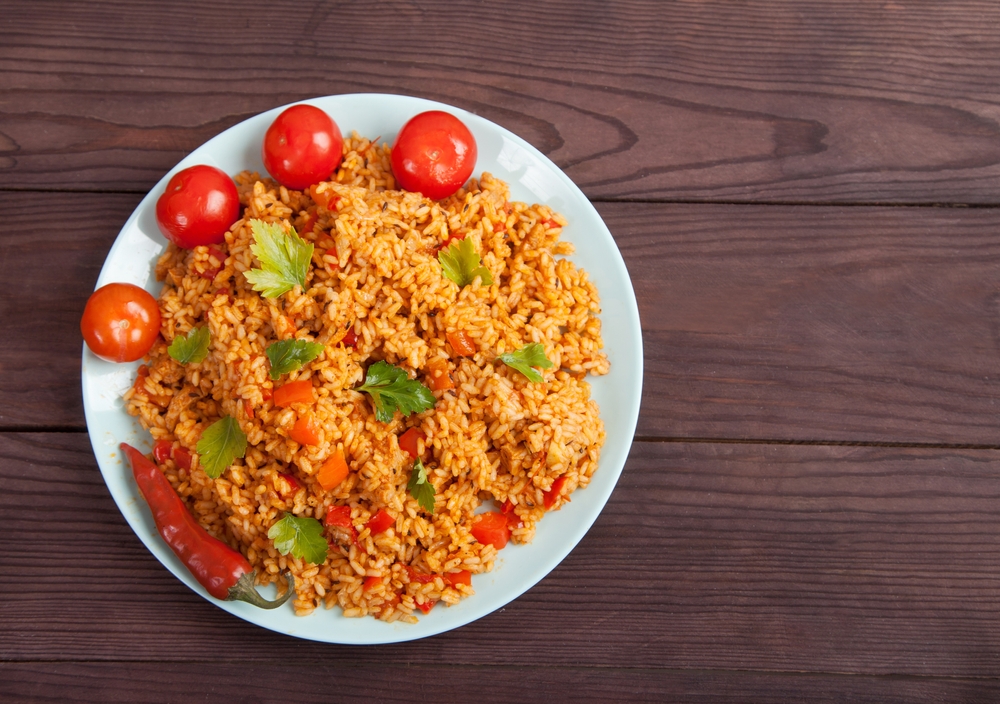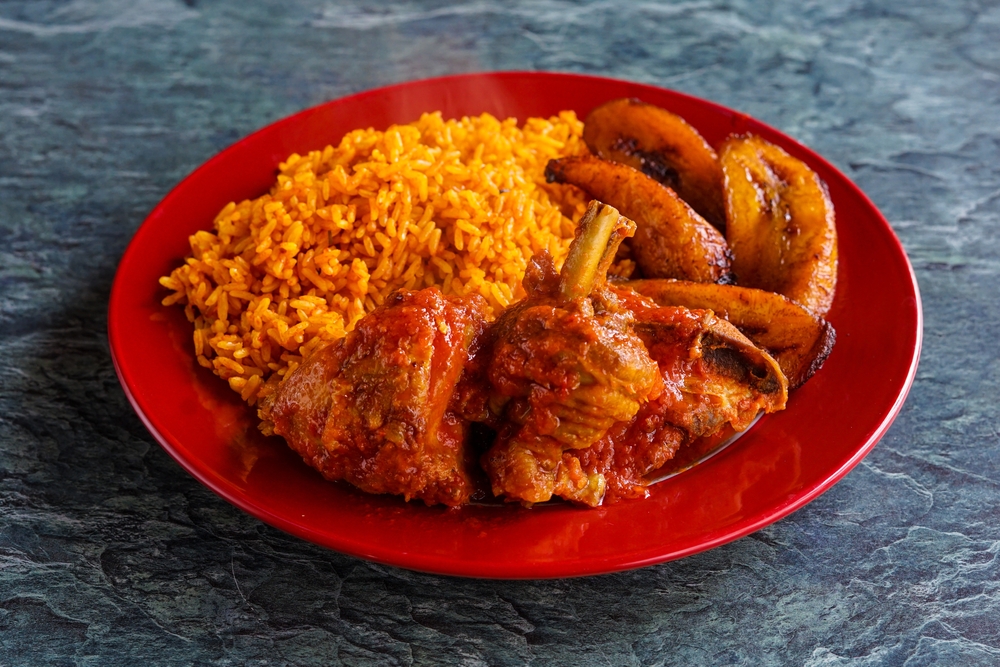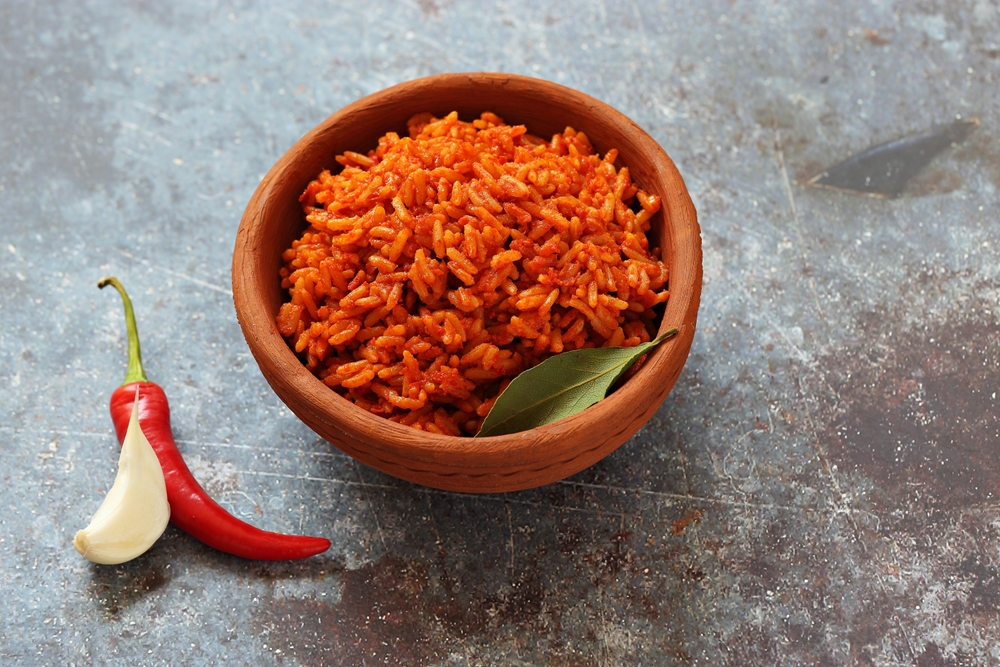Jollof Rice is more than just a dish; it’s a symphony of flavors that tells the story of West Africa. A vibrant medley of spices, rice, and often meats or vegetables, it’s not just a meal but an experience that’s deeply embedded in the culture and traditions of the region.
Introduction to Jollof Rice
Dive into the world of Jollof Rice, a dish that has graced countless festivities, ceremonies, and everyday meals, making it one of Africa’s most iconic and beloved foods.

The rich history and origin of Jollof Rice
Jollof Rice’s roots trace back to the Senegambian region ruled by the Jolof Empire, hence the name. While the precise historical details might be shrouded in mystery, one thing’s for certain: Jollof Rice has been a staple for centuries. As West African nations interacted through trade, conquest, and migration, the dish evolved, with each country adding its unique twist.
The cultural significance in West African celebrations
A West African party without Jollof Rice is considered incomplete by many. Whether it’s a wedding, naming ceremony, or any significant celebration, the tantalizing aroma of Jollof Rice fills the air, signifying a feast and merry times. It’s not just about the taste; it’s about community, unity, and shared heritage. The dish often acts as a binding force, bringing together family and friends in joyous occasions.
Variations across different African countries
While the basic premise of Jollof Rice remains consistent – rice cooked in a blend of tomatoes, peppers, and spices – its execution varies from one nation to another. In Nigeria, it’s often garnished with fried plantains and served with spicy peppered chicken. The Ghanaian version might feature the local long-grain perfumed rice and sometimes a side of Shito, a spicy pepper sauce. Senegal, believed to be the origin of this dish, has its own variant called ‘Thieboudienne,’ often incorporating fish. These regional adaptations showcase the versatility and adaptability of this celebrated dish.
Ingredients and Essential Tools
Embarking on the culinary journey of making Jollof Rice is an invitation to your kitchen to resonate with West African vibes. To ensure the end result is both authentic and delightful, it’s vital to begin with the right ingredients and tools.

The core ingredients for an authentic Jollof Rice
At the heart of Jollof Rice lies a combination of ingredients that give it its distinctive taste and fiery red color:
- Rice: Long-grain parboiled rice is preferred as it holds its shape and doesn’t get mushy.
- Tomatoes: Fresh tomatoes and tomato paste provide the vibrant red base.
- Peppers: Scotch bonnet or habanero peppers add the signature heat. Bell peppers also add to the flavor and color.
- Onions: For depth and sweetness.
- Spices: Thyme, curry powder, bay leaves, and white pepper are common. Some families also have secret spices passed down generations!
- Stock: Chicken, beef, or fish stock amplifies the taste.
- Protein: Options range from chicken, beef, shrimp, or even tofu for a vegetarian twist.
- Oil: Palm oil or vegetable oil, with palm oil giving the traditional reddish tint.
- Others: Garlic, ginger, and sometimes vegetables like peas, carrots, and bell peppers can be added for additional layers of flavor.
Optional additions to enrich flavor and texture
Every chef or home cook has their signature touch to their Jollof Rice, and that often comes in the form of additional ingredients:
- Locust beans (Iru or Ogiri): This fermented ingredient is common in Nigeria and adds a unique depth.
- Smoked fish or dried shrimp: Infuses an earthy taste, especially in coastal regions.
- Plantains: Fried ripe plantains (often called Dodo in Nigeria) on the side or incorporated into the dish add sweetness against the spicy backdrop.
Kitchen tools and equipment for the perfect cook
The art of cooking Jollof Rice requires more than just ingredients; the right tools ensure even cooking and authentic taste:
- Heavy-bottomed pot or Dutch oven: Helps in even heat distribution and prevents burning.
- Wooden spoon: To stir without breaking the rice grains.
- Blender or food processor: Essential for making the tomato and pepper blend.
- Rice strainer: To wash the rice and get rid of excess starch.
- Meat thermometer: If using chicken or meats, ensures they’re cooked to the right temperature.
Step-by-Step Guide to Making Jollof Rice
Transforming humble ingredients into the iconic Jollof Rice is a process that marries tradition with technique. This guide aims to capture the essence of this West African classic, ensuring every bite transports you to the vibrant streets and joyous celebrations of its homeland.
Preparing the ingredients
Setting up before the actual cooking process ensures a smoother experience. Here’s how to get your ingredients ready:
- Rice: Wash the rice in cold water 2-3 times or until the water runs clear. This removes excess starch and prevents stickiness.
- Tomato Blend: In a blender, combine the fresh tomatoes, bell peppers, scotch bonnet or habanero peppers, onions, garlic, and ginger. Blend until smooth. This forms the base of your Jollof sauce.
- Protein Prep: If using chicken or beef, season with salt, pepper, a touch of thyme, and curry powder. Brown them slightly in the pot you’ll be using, then set aside. For seafood, ensure they’re cleaned and set aside.
Cooking and layering process
The heart of Jollof Rice is in its layered cooking, where each element infuses its essence:
- Base Sauce: Heat oil and sauté a finely chopped onion until translucent in your pot or Dutch oven. Add the tomato paste and fry for a few minutes to reduce its tanginess. Then, introduce the blended tomato-pepper mixture. Cook this down until it reduces by half and the oil starts to float on top.
- Seasoning: Add your spices – thyme, curry powder, bay leaves, and any other preferred seasonings. Pour in the stock (chicken, beef, or fish), and let simmer for 10 minutes.
- Rice: Introduce the washed rice into the pot, stirring gently to ensure each grain is coated in the sauce. If using palm oil, now’s the time to add for that signature Jollof hue.
- Layering: If using meats, layer them at the top. This allows the flavors to seep down into the rice as it cooks.
- Cooking: Reduce the heat to the lowest, cover the pot with aluminum foil before placing the lid. This traps the steam, ensuring even cooking. Cook for 20-30 minutes, occasionally checking to ensure it’s not burning at the bottom. If rice isn’t cooked and the dish seems dry, add a bit of stock or water and continue cooking.
Serving suggestions and pairings
Jollof Rice is a showstopper on its own, but certain accompaniments elevate the experience:
- Proteins: Grilled chicken, fried fish, or beef skewers are classic pairings.
- Sides: A simple salad with lettuce, tomatoes, cucumbers, and onions, drizzled with a light vinaigrette, offers a fresh contrast. Fried plantains bring in a sweet element.
- Sauces: Shito (spicy pepper sauce) or a light tomato and onion sauce can be served on the side.
- Drink Pairing: A cold glass of palm wine or ginger beer complements the spicy flavors perfectly.
Jollof Rice Recipe for 4 People

Ingredients:
- Rice:
- 2 cups of long-grain parboiled rice
- Tomatoes and Peppers:
- 4 large fresh tomatoes, roughly chopped
- 1 can (70g) of tomato paste
- 2 red bell peppers, deseeded and roughly chopped
- 1-2 scotch bonnet or habanero peppers (adjust to heat preference)
- Onions:
- 1 large onion (half finely chopped for sautéing, half for blending)
- Spices and Herbs:
- 1 teaspoon of thyme
- 1 teaspoon of curry powder
- 2 bay leaves
- 1/2 teaspoon of white pepper
- Salt to taste
- Stock:
- 2 cups of chicken, beef, or vegetable stock
- Protein (Optional):
- 4 chicken thighs or drumsticks or
- 200g beef cut into chunks or
- 200g cleaned shrimp
- Oil:
- 1/2 cup of palm oil or vegetable oil
- Others:
- 2 cloves of garlic, minced
- 1 inch of ginger, minced
- Optional veggies like 1/2 cup of peas, 1/2 cup diced carrots
Instructions:
- Preparation:
- Wash the rice in cold water until the water runs clear. Drain and set aside.
- Combine the tomatoes, half of the onion, bell peppers, scotch bonnet peppers, garlic, and ginger in a blender. Blend until smooth.
- If using meat, season with a bit of salt, pepper, thyme, and curry. Slightly brown in your cooking pot and set aside.
- Cooking Jollof Rice:
- In your pot or Dutch oven, heat the oil. Add the finely chopped half of the onion and sauté until translucent.
- Stir in the tomato paste and fry for 3-4 minutes.
- Pour in the blended tomato-pepper mixture. Allow it to cook down until the volume reduces by half and you see the oil surfacing on top.
- Add thyme, curry powder, bay leaves, white pepper, and salt. Stir well.
- Pour in the stock and bring to a simmer.
- Gently stir in the washed rice ensuring it’s well-coated in the tomato mixture.
- If using protein, place it on top so its flavors seep into the rice.
- Reduce heat to the lowest, seal the pot with aluminum foil before placing the lid. This ensures even steam distribution.
- Cook for 20-30 minutes. Check occasionally to ensure it doesn’t burn at the bottom. If rice isn’t fully cooked and seems dry, add a bit more stock or water and continue cooking until done.
- If using optional veggies, you can stir them in about 10 minutes before the rice finishes cooking.
- Serving:
- Serve the Jollof Rice hot with your choice of protein and optional sides such as salad or fried plantains.
